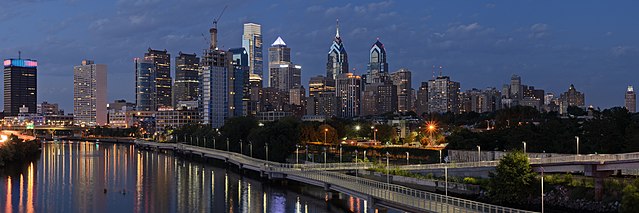Pennsylvania_metropolitan_areas
Pennsylvania has 14 U.S. Census Bureau-designated metropolitan statistical areas (MSAs) and four combined statistical areas (CSAs). As of 2020, Philadelphia, the seventh-largest United States metropolitan area, is the state's largest metropolitan area followed by Pittsburgh and Allentown.[1]
This article needs additional citations for verification. (September 2018) |


The following sortable table lists the 18 MSAs of the Commonwealth of Pennsylvania, including:
- The MSA rank by population as of July 1, 2020, as estimated by the United States Census Bureau[1]
- The MSA name as designated by the United States Office of Management and Budget[2]
- The MSA population as of April 1, 2020, as enumerated by the 2020 United States census[1]
- The MSA population as of April 1, 2010, as enumerated by the 2010 United States census[1]
- The percent MSA population change from April 1, 2010, to July 1, 2020[1]
- The combined statistical area (CSA)[3] if the MSA is a component[2]
More information Rank, Metropolitan statistical area ...
Close
The following sortable table lists the combined statistical areas (CSAs) of the Commonwealth of Pennsylvania with the following information:
- CSA rank by population as of July 1, 2020, as estimated by the United States Census Bureau[4][5]
- The CSA name as designated by the United States Office of Management and Budget[2]
- The CSA population as of July 1, 2020, as estimated by the United States Census Bureau[6]
- CSA population as of April 1, 2010, as enumerated by the 2010 United States Census[6]
- Percent CSA population change from April 1, 2010, to July 1, 2020[6]
- Core Based Statistical Areas (CBSAs) that constitute the CSA[2]
(Metropolitan Statistical Areas that are not combined with other MSAs or CBSAs are not also listed below.)
For a list of all US metropolitan areas see List of primary statistical areas of the United States
More information Rank, Combined Statistical Area ...
Close
- "Metropolitan and Micropolitan Statistical Areas Population Totals and Components of Change: 2010-2020". United States Census Bureau, Population Division. April 2020. Retrieved May 20, 2021.
- The United States Office of Management and Budget (OMB) defines a CSA (CSA) as an aggregate of adjacent core-based statistical areas that are linked by commuting ties.
- "Annual Estimates of the Resident Population for Counties and County-Equivalents: April 1, 2010 to July 1, 2020" (XLS). 2020 Population Estimates. United States Census Bureau, Population Division. April 2021. Retrieved July 21, 2021.
- "Annual Estimates of the Resident Population: April 1, 2010 to July 1, 2020" (XLS). 2020 Population Estimates. United States Census Bureau, Population Division. June 2021. Retrieved July 21, 2021.
- "Metropolitan and Micropolitan Statistical Areas Population Totals and Components of Change: 2010-2019". United States Census Bureau, Population Division. March 26, 2020. Retrieved April 26, 2020.
This Pennsylvania-related article is a stub. You can help Wikipedia by expanding it. |